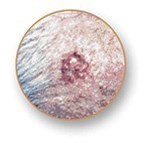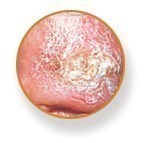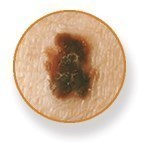Types of skin cancer
Skin cancer
What is skin cancer?
It’s an abnormal growth of skin cells, which is usually caused by the sun’s harmful rays.
Caught early, skin cancer is highly treatable.
Is skin cancer contagious? No
The type of skin cancer a person gets is determined by where the cancer begins. If the cancer begins in skin cells called basal cells, the person has basal cell skin cancer. When cells that give our skin its color become cancerous, melanoma develops.
Here you’ll see what the most common types of skin cancer can look like and who tends to develop each type.
What does skin cancer look like?

This is the most common type of skin cancer.
BCC frequently develops in people who have fair skin. People who have skin of color also get this skin cancer.
BCCs often look like a flesh-colored round growth, pearl-like bump, or a pinkish patch of skin.
BCCs usually develop after years of frequent sun exposure or indoor tanning.
BCCs are common on the head, neck, and arms; however, they can form anywhere on the body, including the chest, abdomen, and legs.
Early diagnosis and treatment for BCC are important. BCC can grow deep. Allowed to grow, it can penetrate the nerves and bones, causing damage and disfigurement.

SCC is the second most common type of skin cancer.
People who have light skin are most likely to develop SCC. This skin cancer also develops in people who have darker skin.
SCC often looks like a red firm bump, scaly patch, or a sore that heals and then re-opens.
SCC tends to form on skin that gets frequent sun exposure, such as the rim of the ear, face, neck, arms, chest, and back.
SCC can grow deep into the skin, causing damage and disfigurement.
Early diagnosis and treatment can prevent SCC from growing deep and spreading to other areas of the body.

People who get AKs usually have fair skin.
AKs usually form on the skin that gets lots of sun exposure, such as the head, neck, hands, and forearms.
Because an AK can turn into a type of skin cancer, treatment is important.

Melanoma is often called "the most serious skin cancer" because it has a tendency to spread.
Melanoma can develop within a mole that you already have on your skin or appear suddenly as a dark spot on the skin that looks different from the rest.
Early diagnosis and treatment are crucial.
Knowing the ABCDE warning signs of melanoma can help you find an early melanoma.
 Atopic dermatitis: More FDA-approved treatments
Atopic dermatitis: More FDA-approved treatments
 Biosimilars: 14 FAQs
Biosimilars: 14 FAQs
 How to trim your nails
How to trim your nails
 Relieve uncontrollably itchy skin
Relieve uncontrollably itchy skin
 Fade dark spots
Fade dark spots
 Untreatable razor bumps or acne?
Untreatable razor bumps or acne?
 Tattoo removal
Tattoo removal
 Scar treatment
Scar treatment
 Free materials to help raise skin cancer awareness
Free materials to help raise skin cancer awareness
 Dermatologist-approved lesson plans, activities you can use
Dermatologist-approved lesson plans, activities you can use
 Find a Dermatologist
Find a Dermatologist
 What is a dermatologist?
What is a dermatologist?